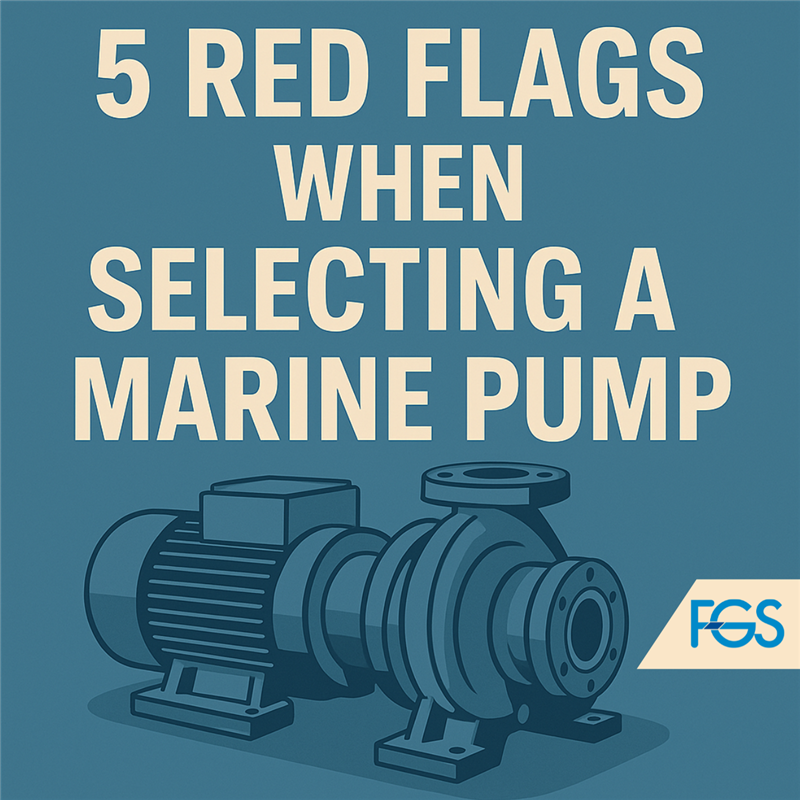Pumps ensure that everything from engine cooling to bilge management runs smoothly. However, selecting the wrong pump, such as using a general-purpose pump for a particular marine function, can lead to unexpected breakdowns, expensive port stops, and even damage vital systems like the engine or the bilge pump.
In this post, we highlight five warning signs to watch out for when choosing a pump and how to ensure your selection process protects your fleet’s uptime and your bottom line.
1. Matching Between Pump Type and Application
Why it’s a red flag: Using a general-purpose pump for a specific marine function (e.g., sludge, seawater, fuel) can lead to rapid wear and inefficiency, potentially causing unexpected breakdowns and costly repairs.
Avoid it by consulting a supplier who understands marine applications and offers technical guidance specific to your vessel type and route.
2. Materials Compatibility
Why is it a red flag: Pumps made from incompatible materials (e.g., cast iron in saltwater environments) can corrode quickly, causing leaks and safety risks.
Avoid it by ensuring materials resist the operating medium — bronze, duplex, or special alloys for aggressive fluids or seawater.
3. Go beyond the Price (play close attention to the Lifecycle Cost)
Why it’s a red flag: While opting for the cheapest pump may seem like a cost-effective choice initially, frequent maintenance, spare parts, or premature failure could lead to higher long-term costs.
Avoid it by considering TCO (Total Cost of Ownership), which refers to energy use, reliability, spare part availability, and after-sales support. For example, VFD pumps may have a higher upfront cost, but they can save more in the long run!
4. Evaluate Real Onboard Operating Conditions
Why it’s a red flag: A pump that looks good on paper may underperform in real-world marine conditions, such as tight installation spaces, fluctuating temperatures, or high-vibration environments.
How to avoid it: Share full details of your onboard setup and constraints with your supplier. An experienced partner can help select or adapt a solution that performs reliably in your vessel's daily conditions.
5. Ensure After-Sales Support or Spare Parts Availability
Why is it a red flag: In case of failure at sea, access to spare parts or technical help is critical. Delays can mean forced downtime.
By partnering with a supplier that offers a global support network, fast shipping, and technical consulting, you can ensure that you have the necessary support in case of a pump failure, providing peace of mind and minimising downtime.
Selecting the right marine pump involves specs, safety, compliance, and keeping your vessel operational. Avoiding these five red flags will help you make a smarter, long-term investment in your fleet.
At Fluid Global Solutions, a leading provider of marine pump solutions, we help shipowners and ship managers choose pumps that perform under pressure.
Need help selecting the right pump for your vessel? Contact us at Fluid Global Solutions, and our team of experts will guide you through the process.
In this post, we highlight five warning signs to watch out for when choosing a pump and how to ensure your selection process protects your fleet’s uptime and your bottom line.
1. Matching Between Pump Type and Application
Why it’s a red flag: Using a general-purpose pump for a specific marine function (e.g., sludge, seawater, fuel) can lead to rapid wear and inefficiency, potentially causing unexpected breakdowns and costly repairs.
Avoid it by consulting a supplier who understands marine applications and offers technical guidance specific to your vessel type and route.
2. Materials Compatibility
Why is it a red flag: Pumps made from incompatible materials (e.g., cast iron in saltwater environments) can corrode quickly, causing leaks and safety risks.
Avoid it by ensuring materials resist the operating medium — bronze, duplex, or special alloys for aggressive fluids or seawater.
3. Go beyond the Price (play close attention to the Lifecycle Cost)
Why it’s a red flag: While opting for the cheapest pump may seem like a cost-effective choice initially, frequent maintenance, spare parts, or premature failure could lead to higher long-term costs.
Avoid it by considering TCO (Total Cost of Ownership), which refers to energy use, reliability, spare part availability, and after-sales support. For example, VFD pumps may have a higher upfront cost, but they can save more in the long run!
4. Evaluate Real Onboard Operating Conditions
Why it’s a red flag: A pump that looks good on paper may underperform in real-world marine conditions, such as tight installation spaces, fluctuating temperatures, or high-vibration environments.
How to avoid it: Share full details of your onboard setup and constraints with your supplier. An experienced partner can help select or adapt a solution that performs reliably in your vessel's daily conditions.
5. Ensure After-Sales Support or Spare Parts Availability
Why is it a red flag: In case of failure at sea, access to spare parts or technical help is critical. Delays can mean forced downtime.
By partnering with a supplier that offers a global support network, fast shipping, and technical consulting, you can ensure that you have the necessary support in case of a pump failure, providing peace of mind and minimising downtime.
Selecting the right marine pump involves specs, safety, compliance, and keeping your vessel operational. Avoiding these five red flags will help you make a smarter, long-term investment in your fleet.
At Fluid Global Solutions, a leading provider of marine pump solutions, we help shipowners and ship managers choose pumps that perform under pressure.
Need help selecting the right pump for your vessel? Contact us at Fluid Global Solutions, and our team of experts will guide you through the process.




